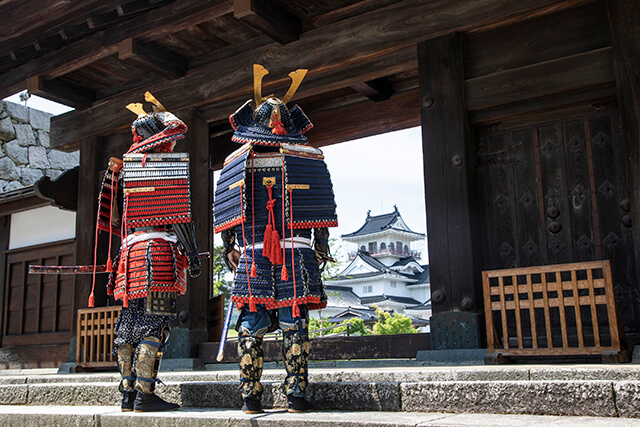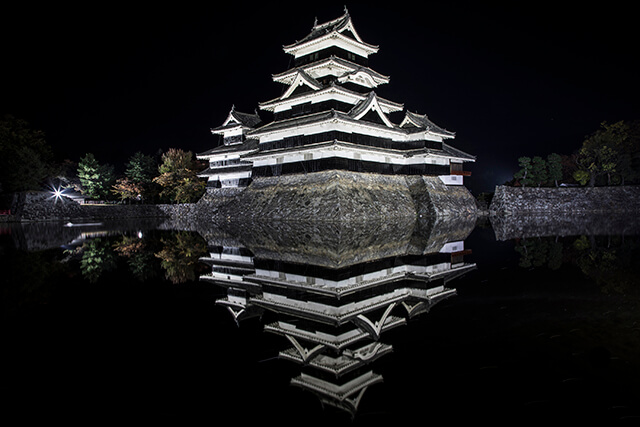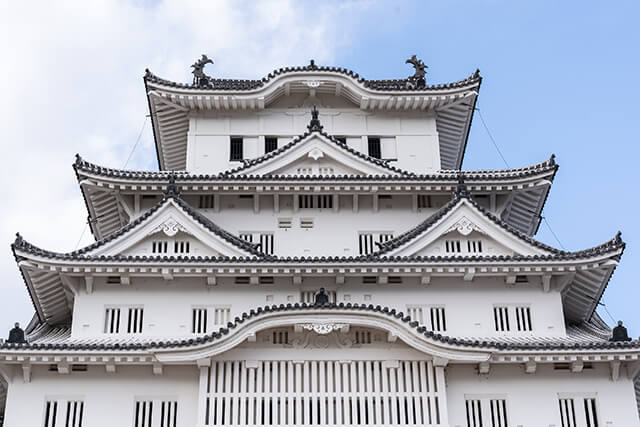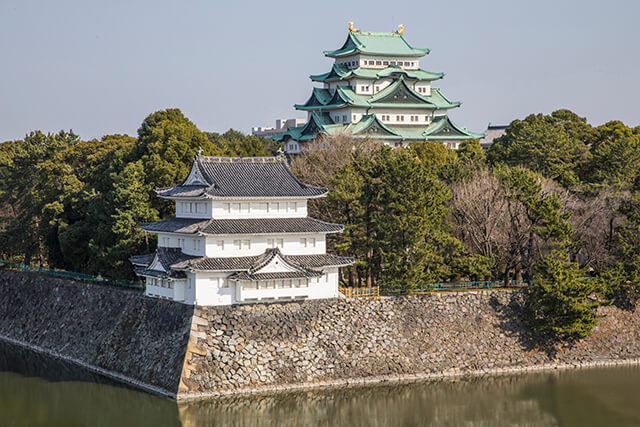
Castles rank alongside shrines and temples as Japan’s most distinctive architectural attractions, with the added romance of their association with samurai warfare (and, at least in fiction, ninja infiltration). If you’d like to add a towering keep or two to your Japan itinerary, read on for a crash course in castle culture!
-
01
The Rise and Fall of the Japanese Castle
The history of castle-building in Japan goes back to fortifications built in prehistoric times. These evolved into fortresses of earth and wood, like the one built at Dazaifu in the seventh century as wars raged on the continent, and eventually yamajiro built directly into mountains. The “classic” Japanese castle, with a multi-story keep (tenshu) on foundations of stone inside a stone-walled bailey (maru), didn’t emerge until the sixteenth century, as warlords struggled for dominance during the Sengoku or “Warring States” period. Oda Nobunaga’s Azuchi Castle was one of the first examples of this new style, built to impress and intimidate. Before long, there were thousands of castles like this across Japan.
When Tokugawa Ieyasu became shogun of a unified Japan, he put a stop to this. His 1615 “One Castle Per Domain” law forced daimyo across Japan to demolish and dismantle the networks of large and small castles they had built to defend their territories, keeping only one each as a base of operations.![Japan’s most well-known castle is Himeji Castle in Hyogo Prefecture]()
Japan’s most well-known castle is Himeji Castle in Hyogo Prefecture
-
02
And Then There Were Twelve
The outlook grew bleaker still for castles when the Meiji Period began in 1868. The nature of warfare had made castles obsolete, and the abolition of the daimyo meant they weren’t even useful as symbols of authority anymore. Some castles were donated to the military, which sometimes tore down the original structures to make room for modern facilities. Other sites were turned into schools, or sold off at bargain-basement prices.
By the early twentieth century, only twenty castles were still standing, usually due to heroic preservation efforts by locals. Eight of these were destroyed in the Second World War, leaving a total of twelve pre-Meiji castles still extant today. The full list is:
・Hirosaki Castle (Aomori Prefecture)
・Matsumoto Castle (Nagano Prefecture)
・Maruoka Castle (Fukui Prefecture)
・Inuyama Castle (Aichi Prefecture)
・Hikone Castle (Shiga Prefecture)
・Himeji Castle (Hyogo Prefecture)
・Matsue Castle (Shimane Prefecture)
・Bitchu Matsuyama Castle (Okayama Prefecture)
・Marugame Castle (Kagawa Prefecture)
・Matsuyama Castle a.k.a. Iyo Matsuyama Castle (Ehime Prefecture)
・Uwajima Castle (Ehime Prefecture)
・Kochi Castle (Kochi Prefecture)![Matsumoto Castle in Nagano Prefecture is also known as “Crow Castle” due to its black exterior, it looks particularly impressive at night reflected in the moat below]()
Matsumoto Castle in Nagano Prefecture is also known as “Crow Castle” due to its black exterior, it looks particularly impressive at night reflected in the moat below
-
03
The Authentic Castle Experience
Naturally, these twelve “original” castles have a certain glamor, and each has something unique to offer visitors. Matsumoto Castle, also called “Crow Castle” because of its forbidding black exterior, is set against the mountainous backdrop of Nagano Prefecture, readily accessible by train or bus from Tokyo. Its firearm museum on the second floor sheds some light on how Sengoku warlords used these weapons.
Himeji Castle, a few minutes’ walk from Himeji Station, is truly gigantic—the largest and most visited in Japan, in fact—and one of the country’s first World Heritage Sites. On a fine day, its white walls dazzle against the blue sky, and this highly photogenic appearance has earned it the nickname “White Heron Castle.”
At Hikone Castle, just east of Lake Biwa in Shiga Prefecture, the rugged tenshu is accompanied by a meticulous reconstruction of the castle’s omote goten—the “Front Hall” built at the base of the hill as a more comfortable place for the daimyo to live and conduct domain business. Along with recreations of bedrooms and reception chambers, the rebuilt omote goten houses a museum showcasing an impressive collection of weapons, armor, and art accumulated by Hikone domain’s ruling Ii family over the generations.![Himeji Castle also known as “White Heron Castle”]()
Himeji Castle also known as “White Heron Castle”
-
04
Modern Reconstructions: Even Better Than the Real Thing?
Of course, a castle doesn’t need to have stood since Edo times to be worth visiting. (In fact, it doesn’t need to be standing at all—the ruins of Nakijin Castle in Okinawa Prefecture are an unforgettable sight.)
![The ruins of Nakijin Castle in Okinawa]()
The ruins of Nakijin Castle in Okinawa
Odawara Castle, a short train ride from Tokyo, was held by the Hojo Clan during the Sengoku Period. Today it has a Hojo Clan museum inside, and an interactive Ninja Museum for kids right next door. Three kilometers to the west, on a hill overlooking Odawara Castle, are the ruins of Ishigakiyama Ichiya (“One-Night”) Castle, built at a breakneck pace in 1590 by Hideyoshi as an exercise in intimidation. (It worked—the Hojo Clan surrendered nine days later, ending the Siege of Odawara.)
Kumamoto Castle in Kyushu is huge, with not one but two tenshu. It was badly damaged in the 2016 Kumamoto Earthquake, but repairs are underway. Nagoya Castle is famous for its golden shachi roof ornaments. These mythical sea creatures with tails that always point toward heaven are supposed to protect the castle from fire with their control over the rains. Osaka Castle was where the Toyotomi Clan made its last stand against the new shogun Tokugawa Ieyasu in 1614 and 1615. The modern reconstruction was built in 1931, with extensive gardens that contrast nicely with the in-your-face urbanism of the surrounding city.![Nagoya Castle in Aichi Prefecture is famous for its golden shachi roof ornaments]()
Nagoya Castle in Aichi Prefecture is famous for its golden shachi roof ornaments
![Many of Japan’s castles offer a host of activities and experiences for tourists, including the chance to dress up in period costume, like here at Toyama Castle.]()
Many of Japan’s castles offer a host of activities and experiences for tourists, including the chance to dress up in period costume, like here at Toyama Castle.
The more castles you visit, the more you’ll notice the subtle architectural differences, from the shape of the stone bailey walls (some elegantly curved, others steep and forbidding) to the “hidden floors” built into some tenshu to confuse the enemy. With over a hundred castles welcoming visitors, not to mention ruins and traces hidden away on hiking trails, there’s more than enough castle in Japan to satisfy even the most avid fan of fortifications.
- Hirosaki Castle Tower
-
-
- Aomori Pref. Hirosakishi Shimoshiroganechou 1
-
-
-
- 0172338733
-
-
-
- [4/1-11/23] 9:00-17:00※4/23…
-
View All- National Treasure Matsumoto Castle
-
4.5
3635 Reviews -
-
- Nagano Pref. Matsumotoshi Marunouchi 4-1
-
-
-
- 0263322902
-
-
-
- 8:30-17:00(Last entry16:30)
-
View All- Maruoka Castle (Kasumigajo)
-
4.0
351 Reviews -
-
- Fukui Pref. Sakaishi Maruokachoukasumichou 1-59
-
-
-
- 0776660303
-
-
-
- 8:30-17:00(Last entry16:30)
-
View All- A National Treasure, Inuyama Castle
-
4.5
1053 Reviews -
-
- Aichi Pref. Inuyamashi Inuyama Kitakoken 65-2
-
-
-
- 0568611711
-
-
-
- 9:00-17:00(Last entry16:30)
-
View All- Hikone Castle
-
4.5
6 Reviews -
-
- Shiga Pref. Hikoneshi Konkichou 1-1
-
-
-
- 0749222742
-
-
-
- 8:30-17:00 (Tenshu Last entr…
-
View All- Himeji Castle
-
-
- Hyogo Pref. Himejishi Honmachi 68
-
-
-
- 0792851146
-
-
-
- 9:00-16:00 (Gates shut is 17…
-
View All- Matsue Castle
-
4.5
1523 Reviews -
-
- Shimane Pref. Matsueshi Tonomachi 1-5
-
-
-
- 0852214030
-
-
-
- [Apr.- Sep.] 8:30-18:30[Oct.…
-
View All- Marugame Castle
-
-
- Kagawa Pref. Marugameshi Ichibanchou
-
-
-
- 0877253881
-
-
-
- 9:00-16:30 (Last entry 16:00…
-
View All- Matsuyama Castle
-
-
- Ehime Pref. Matsuyamashi Marunouchi
-
-
-
- 0899214873
-
-
-
- [Ropeway] [Normal] 8:30-17:…
-
View All- Uwajima Castle
-
-
- Ehime Pref. Uwajimashi Marunouchi 1
-
-
-
- 0895222832
-
-
-
- [Nov.--Feb.] 6:00-17:00[Mar.…
-
View All- Kochi Castle
-
4.0
1177 Reviews -
-
- Kouchi Pref. Kouchishi Marunouchi 1-2-1
-
-
-
- 0888245701
-
-
-
- 9:00-17:00(Last entry16:30)
-
View All






 Go here
Go here















